1
The design, construction, operation and maintenance of steamboats on the upper Peace River was a labour-intensive activity that created an unique industry in the region. For three decades steamboats were to employ a wide range of people in a variety of tasks that were required to keep them carrying passengers and freight along the length of the upper Peace River.2
The S.S. D.A. Thomas.Circa 1928-1930
Shaftesbury Trail, Alberta, Canada
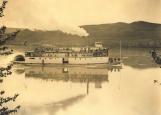 Credits:
Credits:Peace River Museum, Archives & Mackenzie Centre, 2008.056.002
3
The steamboats used on the upper Peace River were, for the most part, specifically designed for operation on the waterways of northern Alberta. Indeed, a great deal of thought went into the design of boats such as the S.S. D.A. Thomas. The designer had to consider river conditions such as current strength and water depth as well as the uses of the boat in creating a steamboat design. They were often limited by having to make salvaged engines and boilers work in their design. Failures in design in upper Peace River design were common. The S.S. Athabasca River, for example, was refitted with new engines and boilers after several years of operation and the design could not handle the weight of the refit, leading to the boat's retirement.The end-result of design is the drawing of the blueprints to be used by boat builders. One example of this is a set of blueprints for the S.S. D.A. Thomas in the Peace River Museum, Archives and Mackenzie Centre.
4
Builder's blueprint for the paddlewheel of the S.S. D.A. Thomas.Circa 1915
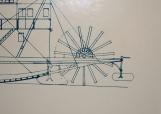 Credits:
Credits:Peace River Museum, Archives & Mackenzie Centre, 87.1547.016
5
The construction of steamboats was to become, along with the building of other types of boats, a major activity on the Peace River. From 1903 to 1915 five steamboats were built locally: the S.S. St. Charles at the St. Augustine Mission (1903); the S.S. Peace River at Fort Vermilion (1905); the S.S. Grenfell (1912), the S.S. Northland Call (1916), and the S.S. D.A. Thomas (1916) at the West Peace River boatyards. In each case the engines, boilers and other "machinery" were shipped overland to the building site and assembled by a specialized boat builder supervising a crew of men. Construction of each of these boats took several months. The boats were built close to the banks of the river so that they could be more easily launched.6
The hull and decks of the S.S. D.A. Thomas under construction.1915-1916
West Peace River, Alberta, Canada
 Credits:
Credits:Provincial Archives of Alberta, A. 10,146
7
One of the steam boilers of the S.S. D.A. Thomas being delivered to the building site.1915-1916
Judah, Alberta, Canada
 Credits:
Credits:Provincial Archives of Alberta, A. 10,149
8
The launch of the S.S. D.A. Thomas.1916
West Peace River, Alberta, Canada
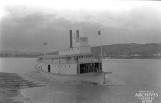 Credits:
Credits:Provincial Archives of Alberta, A. 10,161
9
The operation of steamboats on the upper Peace River was a seasonal activity dictated by the freezing over of the river each winter and the subsequent "break-up" of the ice on the following spring. There was considerable variation each year as to when the river would be free of ice but the general steaming season for boats on the upper Peace River was May to September, with some operation possible in October.10
The S.S. D.A. Thomas heading upriver from Peace River Crossing.circa 1916-1930
Peace River Crossing, Alberta, Canada
 Credits:
Credits:Peace River Museum, Archives & Mackenzie Centre, 72.453y
11
Usually steamboats were "laid up" for the winter months on the banks of the Peace River. Several weeks prior to the start of the operating season the boat crew would begin preparing the boat. This might involve such things as painting the hull and decks, repairs, engine and boiler maintenance, alterations and cleaning. To actually launch the boat a series of wooden planks would be cut and placed so that the boat might slide down them into the water. The actual moving of the boat was done by use of animals or other boats.In general, the steamboats used on the upper Peace River might make three to four "round trips" from the Vermilion Chutes to Fort St. John (and Hudson's Hope less often) each season, with each trip taking roughly a month. The boats were also often used for shorter trips such as excursions from Peace River Crossing to the Shaftesbury Settlment.
12
The S.S. Peace River "drydocked" at Peace River Crossing.Circa 1915-6
Peace River Crossing, Alberta, Canada
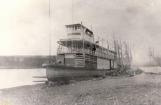 Credits:
Credits:Peace River Museum, Archives & Mackenzie Centre, 75.622.062
13
The steamboats on the upper Peace River were completely dependent on wood for their fuel and one of the major activities for a boat crew was to deal with this fuel. The engines and boilers of the steamboats required a high volume of wood to operate and this had to be dry and ideally cut in ideal lengths depending on the size of the fire box of the boiler. The S.S. Peace River, for example, could use as much as 300 cords of wood each season and this was cut into four foot lengths. Wood would be cut and stored in a series of stopping places along the Peace River. Sometimes passengers would even pay for passage with wood they had cut. Given their limited storage on board for wood steamboats would have to stop almost every day and crews (sometimes with the assistance of passengers) would have to load several cords of wood.Another common activity for steamboat crews was that they would have to cut the wood themselves if there was not enough already cut or if it was not in good condition for use. In 1906, for example, the crew of the S.S. Peace River had to land and cut about half of the wood (160 cords) required for the operating season.
14
The S.S. Peace River at a "Wood Pile" on the Peace River.June-July, 1913
Upriver from Fort St. John, British Columbia, Canada
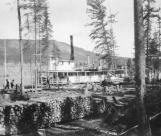 Credits:
Credits:University of Alberta Archives, Arthur Watts Fonds, UAA 76-50-14-163